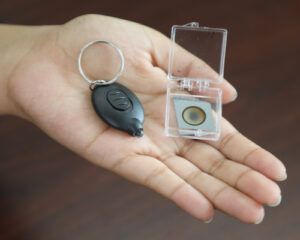A Materials Science Educational Kit available from the Education & Outreach program of the UC San Diego MRSEC
Visualize photoluminescence from silicon quantum dots!



Subject of the 2023 Nobel Prize in Chemistry, quantum dots are nanoparticles made from solid materials known as semiconductors that are finding uses in a wide range of applications, from medical diagnostic systems, to solar cells, to television sets. The most well-known semiconductor is silicon, the material at the heart of all modern microelectronics.
When a semiconductor is made into a nanoparticle, electrons in the material behave profoundly differently than they do in the "bulk" large-scale semiconductor. One manifestation of the confinement of an electron in a semiconductor nanoparticle is the visible photoluminescence seen with this sample--the color of luminescence is directly related to the confinement dimensions in the silicon nanoparticles.
This module was developed by Ellie Bauer, Keying Deng, Clémentine Gevers, Sophia Hsu, Eileen Huffer-Ege, Louise Lejeune, Siran Rao, Jocelyn Zhang, and Ashley Tamura, who were trainees or mentors in the 2022 and 2023 Summer School for Silicon Nanotechnology (SSSiN), one of the Research Immersion in Materials Science and Engineering (RIMSE) programs of the UC San Diego MRSEC.
What is it?

A 1-inch silicon wafer containing a nano-sponge array of silicon quantum dots. This kit contains a non-toxic sample of silicon quantum dots, which glow with a bright color when placed under a small ultraviolet, or "black" light. The kit explains the concept of photoluminescence, through common materials that display photoluminescence (such as a highlighter pen), and it illustrates the synthesis and properties of quantum dots and describes how they can be configured to display all the colors of the rainbow-an enabling feature for their current application in computer displays and televisions.
How to use it?

This kit contains a small "blacklight" which emits ultraviolet light of wavelength 395 nm. This blacklight can be used to excite photoluminescence from a variety of materials, including the silicon "quantum dot" sample supplied in the kit. Under normal room lights, the quantum dot sample will have a dull brownish appearance. To see photoluminescence in action, simply shine UV light (from the blacklight) on the quantum dot sample and observe the red-orange glow, which is light emitted due to photoluminescence from the quantum dots.
How is it made?

(CONTENT UNDER DEVELOPMENT) The procedure used to prepare these materials involves carving nanometer-scale pores into a silicon wafer, using an electrochemical process. The silicon wafers are placed in an electrolyte that contains hydrofluoric acid, water, and alcohol. An electric current is passed through the wafer, which oxidizes and then solubilizes silicon atoms, drilling nanometer-scale holes, or pores, in the process. This material is known as "porous silicon" because of the porous nanostructure. The small silicon features that remain after all the holes are drilled out can be as small as only a few nanometers thick. At this size scale the silicon is transformed into a quantum material. Electrons become trapped and are no longer free to move, a phenomena called quantum confinement.
(CONTENT UNDER DEVELOPMENT) Images of silicon quantum dots and various other photoluminescent samples
Materials and Method for making quantum dot with additional information
Warning: The making of the quantum dots involve harsh conditions and dangerous materials. Please do not attempt to produce quantum dots in a K-12 classroom setting. Quantum dots fabrication should not be undertaken by students under the age of 18 and should always be done in the presence of a second person. Both people should be properly trained by a knowledgeable chemist before proceeding.
How can I get involved?
If you would like to participate in hands-on laboratory research activities, we run Summer Schools in Silicon Nanotechnology, Engineered Living Materials, Predictive Self-Assembly, and Energy Storage Systems. These introduce high school, undergraduate, graduate, and post-graduate trainees to the research elements, the background, and safety procedures needed to work with the relevant materials. The four schools, called RIMSE (Research Immersion in Materials Science and Engineering), are run by the UC San Diego MRSEC center.
